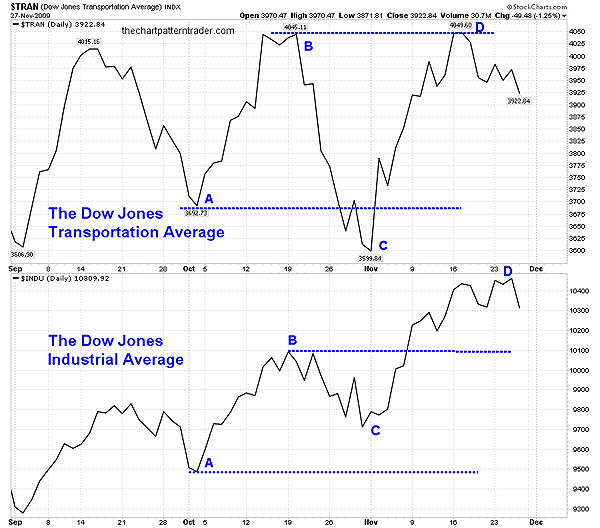
HOT TOPICS LIST
- MACD
- Fibonacci
- RSI
- Gann
- ADXR
- Stochastics
- Volume
- Triangles
- Futures
- Cycles
- Volatility
- ZIGZAG
- MESA
- Retracement
- Aroon
INDICATORS LIST
LIST OF TOPICS
PRINT THIS ARTICLE
by Ron Walker
Recently, the Dow transports reaffirmed the rising intermediate trend on the Dow industrials by making a new closing high. Even though the market is looking toppy at these levels, the intermediate trend has yet to be reversed based on the principles of confirmation found in Dow theory.
Position: N/A
Ron Walker
Ron Walker is an active trader and technical analyst. He operates an educational website dedicated to the study of Technical Analysis. The website offers free market analysis with daily video presentations and written commentaries. Ron is a video pioneer, being one of the first to utilize the internet producing Technical Analysis videos. His website is thechartpatterntrader.com
PRINT THIS ARTICLE
DOW THEORY
Dow Theory Principle Of Confirmation
12/01/09 11:48:31 AMby Ron Walker
Recently, the Dow transports reaffirmed the rising intermediate trend on the Dow industrials by making a new closing high. Even though the market is looking toppy at these levels, the intermediate trend has yet to be reversed based on the principles of confirmation found in Dow theory.
Position: N/A
| Out of all the tenets that make up Dow theory, the principle of confirmation is one of the most controversial. This principle simply means that the two Dow Jones averages (the Dow Jones Industrial Average [DJIA] and the Dow Jones Transportation Average [TRAN]) must confirm each other. Thus, a new high in the DJIA will require a new high on the TRAN in order to confirm the signal. Only closing prices are used. Dow theory ignores intraday extreme highs or lows. The averages do not have to confirm each other simultaneously, but they usually trend together over the long term, which makes the principle of confirmation extremely important. |
| If the DJIA moves to a new high, the transports must confirm the move and eventually make a new high. Failure to do so calls the trend into question. Robert Edwards and John Magee characterize the principle of confirmation this way in their book, Technical Analysis Of Stock Trends: "What it means is that no valid signal of a change in trend can be produced by the action of one average alone." |

|
| FIGURE 1: $TRAN, $INDU, DAILY. In the upper window, TRAN made a lower low at point C, moving below A. In the lower window, when the DJIA fell to point C, it remained higher than A, then climbed higher to D. Later, TRAN slightly crept above point B to D to reaffirmed the uptrend. |
| Graphic provided by: StockCharts.com. |
| |
| In Figure 1, after a brief correction concluded in early October at point A, both averages went on to make a new highs at point B. On the next decline, the DJIA fell to point C, which is higher than A, then climbed higher to D, which exceeds B. Meanwhile, the transports fell from point B to C, moving beyond point A, making a lower low. Then the transports rallied back up to point D, which only slightly exceeded point B. Even though point D exceeded point B by only four points, it is still a valid penetration, because in Dow theory, any penetration, regardless how small it may be, is regarded as a valid signal. |
| Therefore, from this action, we can conclude that the DJIA failed to confirm the transport's lower low at point C, by not penetrating that level. Next, we can deduce that the transports did reaffirm the uptrend by following the DJIA by moving above point B. In doing so, the bullish confirmation to new highs by both averages canceled out all previous signals. Therefore, the bearish forces that carried the transports to make a lower low at point C have been counteracted, and the signal has been nullified. |
| So the new crucial level to watch on the averages is at point C (the last significant minor low). If both averages penetrate below it and make a fresh lows, then on the next recovery prices fail to exceed point D, and then turn back down and fall below those fresh lows, it would reverse the intermediate trend. Even though the transports did confirm the November highs made on the DJIA, both averages are showing signs of being overbought in the daily and weekly time frames, which ultimately may lead to an overdue correction. So Dow theorists should closely monitor the previous lows made at point C, watching for any signs of penetration. |
Ron Walker is an active trader and technical analyst. He operates an educational website dedicated to the study of Technical Analysis. The website offers free market analysis with daily video presentations and written commentaries. Ron is a video pioneer, being one of the first to utilize the internet producing Technical Analysis videos. His website is thechartpatterntrader.com
| Website: | thechartpatterntrader.com |
| E-mail address: | thechartpatterntrader@gmail.com |
Click here for more information about our publications!
Comments
Date: 12/02/09Rank: 2Comment:

|

Request Information From Our Sponsors
- StockCharts.com, Inc.
- Candle Patterns
- Candlestick Charting Explained
- Intermarket Technical Analysis
- John Murphy on Chart Analysis
- John Murphy's Chart Pattern Recognition
- John Murphy's Market Message
- MurphyExplainsMarketAnalysis-Intermarket Analysis
- MurphyExplainsMarketAnalysis-Visual Analysis
- StockCharts.com
- Technical Analysis of the Financial Markets
- The Visual Investor
- VectorVest, Inc.
- Executive Premier Workshop
- One-Day Options Course
- OptionsPro
- Retirement Income Workshop
- Sure-Fire Trading Systems (VectorVest, Inc.)
- Trading as a Business Workshop
- VectorVest 7 EOD
- VectorVest 7 RealTime/IntraDay
- VectorVest AutoTester
- VectorVest Educational Services
- VectorVest OnLine
- VectorVest Options Analyzer
- VectorVest ProGraphics v6.0
- VectorVest ProTrader 7
- VectorVest RealTime Derby Tool
- VectorVest Simulator
- VectorVest Variator
- VectorVest Watchdog
